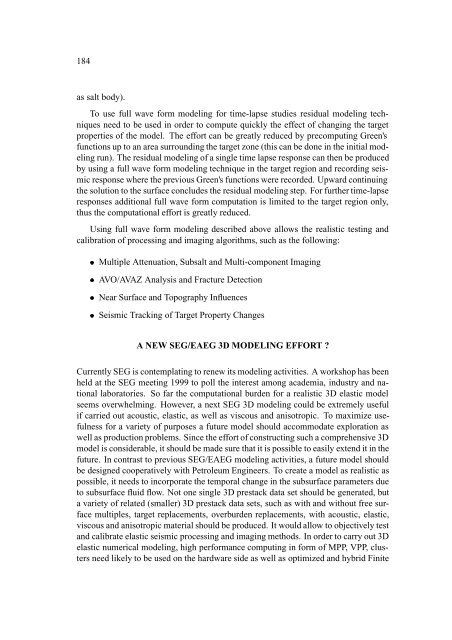Wave Inversion Technology - WIT
Wave Inversion Technology - WIT
Wave Inversion Technology - WIT
Create successful ePaper yourself
Turn your PDF publications into a flip-book with our unique Google optimized e-Paper software.
184<br />
as salt body).<br />
To use full wave form modeling for time-lapse studies residual modeling techniques<br />
need to be used in order to compute quickly the effect of changing the target<br />
properties of the model. The effort can be greatly reduced by precomputing Green's<br />
functions up to an area surrounding the target zone (this can be done in the initial modeling<br />
run). The residual modeling of a single time lapse response can then be produced<br />
by using a full wave form modeling technique in the target region and recording seismic<br />
response where the previous Green's functions were recorded. Upward continuing<br />
the solution to the surface concludes the residual modeling step. For further time-lapse<br />
responses additional full wave form computation is limited to the target region only,<br />
thus the computational effort is greatly reduced.<br />
Using full wave form modeling described above allows the realistic testing and<br />
calibration of processing and imaging algorithms, such as the following:<br />
Multiple Attenuation, Subsalt and Multi-component Imaging<br />
AVO/AVAZ Analysis and Fracture Detection<br />
Near Surface and Topography Influences<br />
Seismic Tracking of Target Property Changes<br />
A NEW SEG/EAEG 3D MODELING EFFORT <br />
Currently SEG is contemplating to renew its modeling activities. A workshop has been<br />
held at the SEG meeting 1999 to poll the interest among academia, industry and national<br />
laboratories. So far the computational burden for a realistic 3D elastic model<br />
seems overwhelming. However, a next SEG 3D modeling could be extremely useful<br />
if carried out acoustic, elastic, as well as viscous and anisotropic. To maximize usefulness<br />
for a variety of purposes a future model should accommodate exploration as<br />
well as production problems. Since the effort of constructing such a comprehensive 3D<br />
model is considerable, it should be made sure that it is possible to easily extend it in the<br />
future. In contrast to previous SEG/EAEG modeling activities, a future model should<br />
be designed cooperatively with Petroleum Engineers. To create a model as realistic as<br />
possible, it needs to incorporate the temporal change in the subsurface parameters due<br />
to subsurface fluid flow. Not one single 3D prestack data set should be generated, but<br />
a variety of related (smaller) 3D prestack data sets, such as with and without free surface<br />
multiples, target replacements, overburden replacements, with acoustic, elastic,<br />
viscous and anisotropic material should be produced. It would allow to objectively test<br />
and calibrate elastic seismic processing and imaging methods. In order to carry out 3D<br />
elastic numerical modeling, high performance computing in form of MPP, VPP, clusters<br />
need likely to be used on the hardware side as well as optimized and hybrid Finite







